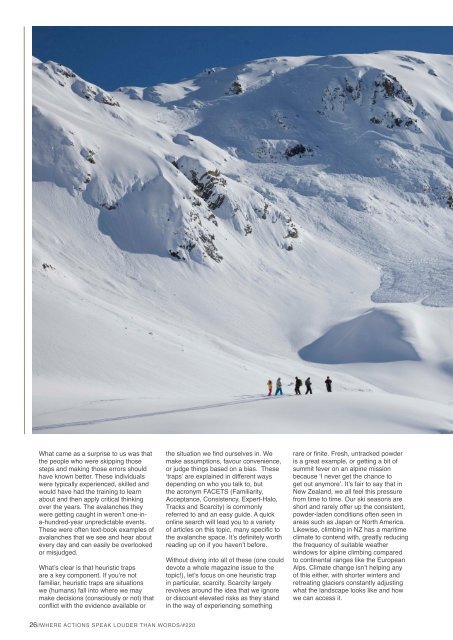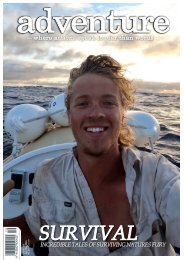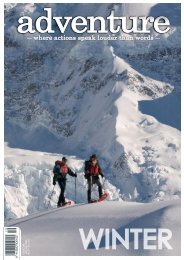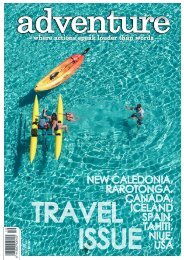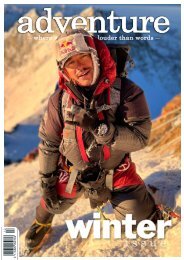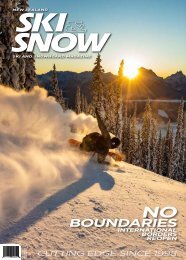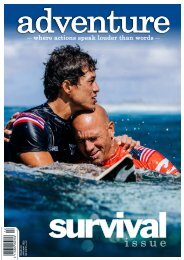Adventure Magazine Issue 220
Issue 220: June/July Winter 2020
Issue 220: June/July
Winter 2020
You also want an ePaper? Increase the reach of your titles
YUMPU automatically turns print PDFs into web optimized ePapers that Google loves.
While there are plenty of reasons to believe that<br />
that opportunities in the backcountry are scarce,<br />
there is still no justification for downplaying<br />
dangers that are present when you are out there.<br />
Over the last 20 years a large proportion of the<br />
avalanche fatalities in NZ involve the scarcity<br />
heuristic trap. These were usually individuals not<br />
who weren’t ignorant to the dangers in front of<br />
them. Most would have been able to identify the<br />
hazard. But, for various reasons, they decided to<br />
accept an elevated level of risk because ‘scarcity’<br />
influenced their decision making.<br />
A clear, reoccurring example of this comes to<br />
mind. I’ve heard numerous times ‘considerable’<br />
avalanche danger referred to as “3 out of 5” or an<br />
“orange”. This is missing the point. The danger<br />
scale isn’t like ski-run grades or mountain-bike<br />
track grades. In those cases, the black runs<br />
are more difficult and dangerous, but they are<br />
designed to be ridden. “Extreme” avalanche<br />
danger is not, nor is “high” for that matter. These<br />
are times to avoid avalanche terrain altogether.<br />
“Considerable” avalanche danger effectively<br />
means treating the snowpack like you would your<br />
most challenging ski-runs and bike-tracks. It’s<br />
going to require high-level experience and skills to<br />
navigate through and pick the right line. And even<br />
then, sometimes it’s just best to save it for another<br />
day.<br />
It’s easy to fall into the trap of thinking, “I’ve got<br />
this chance, I have to take it”. But as scarce as<br />
those moments are (even in New Zealand!), there<br />
will always be more. That might not be true if you<br />
make the wrong choice and put the goal ahead of<br />
the evidence.<br />
“But it is one thing to read about dragons and<br />
another to meet them.”<br />
-Ursula K. Le Guin, A Wizard of Earthsea<br />
What came as a surprise to us was that<br />
the people who were skipping those<br />
steps and making those errors should<br />
have known better. These individuals<br />
were typically experienced, skilled and<br />
would have had the training to learn<br />
about and then apply critical thinking<br />
over the years. The avalanches they<br />
were getting caught in weren’t one-ina-hundred-year<br />
unpredictable events.<br />
These were often text-book examples of<br />
avalanches that we see and hear about<br />
every day and can easily be overlooked<br />
or misjudged.<br />
What’s clear is that heuristic traps<br />
are a key component. If you’re not<br />
familiar, heuristic traps are situations<br />
we (humans) fall into where we may<br />
make decisions (consciously or not) that<br />
conflict with the evidence available or<br />
the situation we find ourselves in. We<br />
make assumptions, favour convenience,<br />
or judge things based on a bias. These<br />
‘traps’ are explained in different ways<br />
depending on who you talk to, but<br />
the acronym FACETS (Familiarity,<br />
Acceptance, Consistency, Expert-Halo,<br />
Tracks and Scarcity) is commonly<br />
referred to and an easy guide. A quick<br />
online search will lead you to a variety<br />
of articles on this topic, many specific to<br />
the avalanche space. It’s definitely worth<br />
reading up on if you haven’t before.<br />
Without diving into all of these (one could<br />
devote a whole magazine issue to the<br />
topic!), let’s focus on one heuristic trap<br />
in particular, scarcity. Scarcity largely<br />
revolves around the idea that we ignore<br />
or discount elevated risks as they stand<br />
in the way of experiencing something<br />
rare or finite. Fresh, untracked powder<br />
is a great example, or getting a bit of<br />
summit fever on an alpine mission<br />
because ‘I never get the chance to<br />
get out anymore’. It’s fair to say that in<br />
New Zealand, we all feel this pressure<br />
from time to time. Our ski seasons are<br />
short and rarely offer up the consistent,<br />
powder-laden conditions often seen in<br />
areas such as Japan or North America.<br />
Likewise, climbing in NZ has a maritime<br />
climate to contend with, greatly reducing<br />
the frequency of suitable weather<br />
windows for alpine climbing compared<br />
to continental ranges like the European<br />
Alps. Climate change isn’t helping any<br />
of this either, with shorter winters and<br />
retreating glaciers constantly adjusting<br />
what the landscape looks like and how<br />
we can access it.<br />
For your regions avalanche forecast,<br />
visit the New Zealand Avalanche<br />
Advisory at avalanche.net.nz, owned<br />
and managed by the New Zealand<br />
Mountain Safety Council (MSC). Here<br />
you can also find useful resources<br />
such as our online avalanche course,<br />
avalanche safety videos, and a list of<br />
avalanche course providers around the<br />
country.<br />
For more information about the<br />
MSC please visit our website www.<br />
mountainsafety.org.nz where you’ll<br />
find outdoor safety tools, resources,<br />
information and heaps more to help you<br />
stay safe in the outdoors no matter what<br />
your pursuit.<br />
26//WHERE ACTIONS SPEAK LOUDER THAN WORDS/#<strong>220</strong> ADVENTUREMAGAZINE.CO.NZ 27


